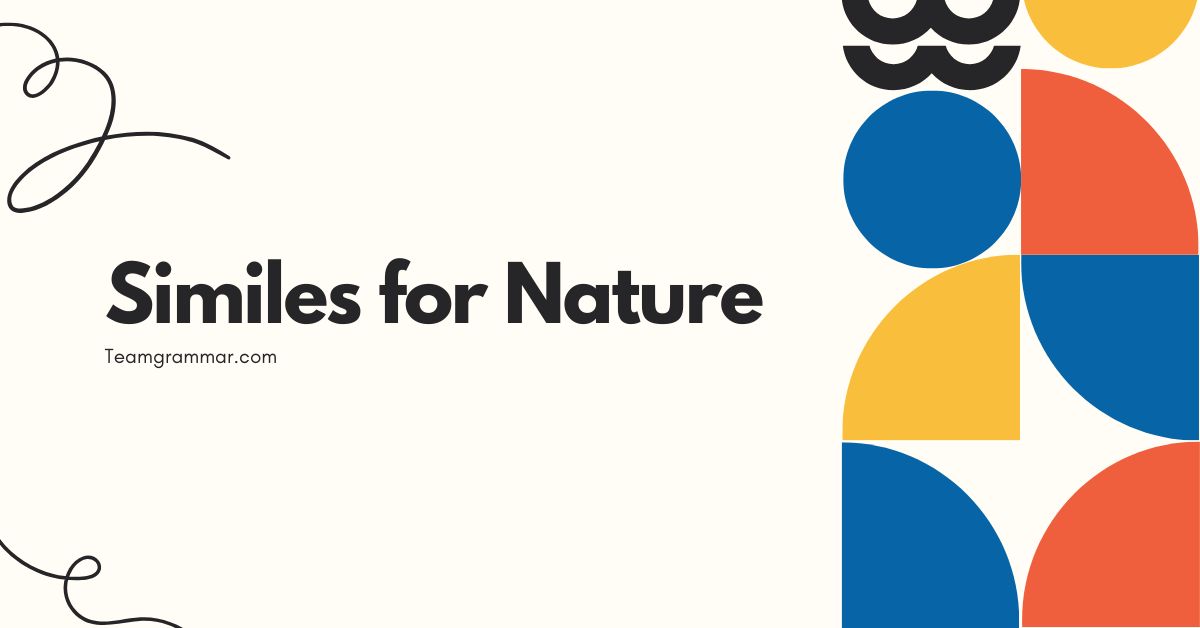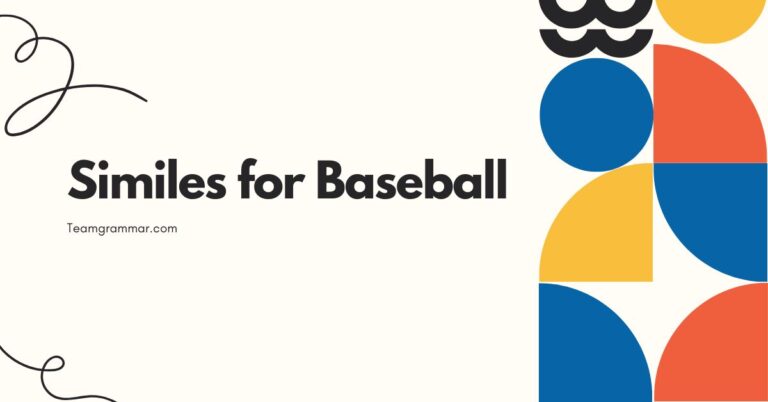27 Similes for Nature: Enhancing Descriptions with Figurative Language
Understanding similes is crucial for enriching your descriptive writing and comprehension skills. Similes, a type of figurative language, allow us to draw comparisons between unrelated things, making our language more vivid and engaging.
This article focuses specifically on similes used to describe nature, providing a comprehensive guide for English language learners and writers looking to enhance their descriptive abilities. Whether you are a student, a writer, or simply someone who enjoys appreciating the beauty of the natural world, mastering similes will undoubtedly elevate your communication skills.
This article will explore the definition, structure, types, and usage of similes in the context of nature. We will delve into numerous examples, common mistakes, and practice exercises to solidify your understanding.
By the end of this guide, you will be well-equipped to use similes effectively and creatively to paint a more vibrant and compelling picture of the natural world.
Table of Contents
- Definition of Similes
- Structural Breakdown of Similes
- Types of Nature Similes
- Examples of Similes for Nature
- Usage Rules for Similes
- Common Mistakes with Similes
- Practice Exercises
- Advanced Topics in Similes
- Frequently Asked Questions
- Conclusion
Definition of Similes
A simile is a figure of speech that directly compares two different things using the words “like” or “as.” The purpose of a simile is to create a vivid and imaginative connection between something familiar and something less familiar, making the description more engaging and understandable. Similes are essential tools in both literature and everyday conversation, allowing us to express complex ideas and evoke strong imagery.
In the context of describing nature, similes help us to appreciate the beauty and complexity of the natural world by drawing parallels to things we already understand and relate to. For example, saying “The river flowed like liquid silver” connects the movement and appearance of the river to the precious metal, enhancing our perception of its beauty.
Structural Breakdown of Similes
The basic structure of a simile consists of three main components:
- The subject: This is the thing being described (e.g., the tree).
- The comparative word: This is either “like” or “as,” which establishes the comparison.
- The object of comparison: This is what the subject is being compared to (e.g., a giant).
A simple formula for constructing a simile is: Subject + “like” or “as” + Object of Comparison.
For example:
- The mountain stood like a sleeping giant.
- The leaves were as green as emeralds.
Understanding this basic structure is crucial for creating effective and clear similes. By mastering the formula, you can easily generate creative and descriptive comparisons.
Types of Nature Similes
Nature similes can be categorized based on the specific aspect of nature they describe. Here are a few common categories:
Similes Describing Appearance
These similes focus on the visual qualities of nature, such as color, shape, and texture. For example, “The sunset was as red as fire” describes the color of the sunset.
Similes Describing Movement
These similes focus on how things in nature move or behave. For example, “The wind howled like a wolf” describes the sound and intensity of the wind.
Similes Describing Sound
These similes focus on the auditory aspects of nature. For example, “The stream babbled like a baby” describes the gentle sound of the stream.
Similes Describing Texture
These similes describe how something in nature feels. For example, “The moss was as soft as velvet” describes the texture of the moss.
Similes Describing Emotion
These similes attribute human emotions to nature. For example, “The forest was as lonely as a forgotten soul” gives the forest a feeling of loneliness.
Examples of Similes for Nature
Here are numerous examples of similes used to describe various aspects of nature, organized by category.
Similes for Trees
Trees are a common subject for similes due to their diverse shapes, sizes, and textures. The following table provides examples of similes that vividly describe trees.
| Simile | Explanation |
|---|---|
| The tree stood as tall as a skyscraper. | Compares the height of the tree to a very tall building. |
| Its branches reached out like welcoming arms. | Compares the branches to arms, suggesting a sense of invitation. |
| The leaves rustled like whispers in the wind. | Compares the sound of the leaves to soft, quiet speech. |
| The bark was as rough as sandpaper. | Compares the texture of the bark to a rough abrasive material. |
| The tree swayed like a dancer in the breeze. | Compares the movement of the tree to a graceful dancer. |
| Roots spread like veins beneath the soil. | Compares the root system to veins, highlighting their intricate network. |
| The old tree stood as a sentinel, guarding the forest. | Compares the tree to a guard, emphasizing its age and protective role. |
| The leaves shimmered like emeralds in the sunlight. | Compares the color and shine of the leaves to precious gems. |
| The branches were as gnarled as an old man’s fingers. | Compares the shape of the branches to the twisted fingers of an elderly person. |
| The tree provided shade like a giant umbrella. | Compares the shade provided by the tree to an umbrella. |
| The trunk was as solid as a rock. | Compares the firmness and stability of the tree trunk to a rock. |
| The sap flowed like blood through its veins. | Compares the sap to blood, emphasizing its life-giving function. |
| The tree’s shadow stretched long like a dark finger. | Compares the tree’s shadow to a long, dark finger, emphasizing its shape. |
| The tree stood silent as a statue. | Compares the tree’s stillness to that of a statue. |
| The canopy was as dense as a green cloud. | Compares the canopy’s density to a cloud. |
| The pine needles were as sharp as needles. | A straightforward comparison emphasizing the sharpness of the pine needles. |
| The tree’s roots gripped the earth like a clenched fist. | Compares the grip of the roots to a tight fist. |
| The tree stood resolute as a warrior. | Compares the tree’s steadfastness to a warrior. |
| The tree’s silhouette was as stark as a charcoal drawing. | Compares the tree’s outline to a charcoal drawing. |
| The tree was as ancient as time itself. | Emphasizes the tree’s age by comparing it to time itself. |
| The tree’s leaves fell like golden rain. | Compares falling leaves to golden rain, emphasizing color and descent. |
| The tree’s branches creaked like an old door. | Compares the sound of creaking branches to an old door. |
| The tree’s leaves danced like ballerinas in the wind. | Compares the movement of the leaves to elegant ballerinas. |
Similes for Water
Water, in its various forms (rivers, lakes, oceans), is another rich source of similes. Below are some examples that capture the essence of water.
| Simile | Explanation |
|---|---|
| The river flowed like liquid glass. | Compares the smooth, reflective surface of the river to glass. |
| The waves crashed like thunder on the shore. | Compares the sound of the waves to the loud roar of thunder. |
| The lake was as still as a mirror. | Compares the stillness of the lake to a mirror’s reflective surface. |
| The ocean stretched out like an endless blue carpet. | Compares the vastness of the ocean to a large carpet. |
| The waterfall cascaded down like a bridal veil. | Compares the flowing water to a delicate bridal veil. |
| The stream gurgled like a playful child. | Compares the sound of the stream to the happy sounds of a child. |
| The water was as cold as ice. | A simple comparison emphasizing the extreme coldness of the water. |
| The sea roared like an angry beast. | Compares the sound and power of the sea to an angry animal. |
| The raindrops fell like tears from the sky. | Compares raindrops to tears, suggesting a sense of sadness or cleansing. |
| The water sparkled like diamonds in the sun. | Compares the sparkle of the water to the brilliance of diamonds. |
| The tide ebbed and flowed like a rhythmic breath. | Compares the movement of the tide to breathing. |
| The pond was as green as pea soup. | Compares the color of the pond to pea soup, possibly suggesting algae. |
| The rapids churned like a washing machine. | Compares the turbulent movement of the rapids to a washing machine. |
| The water was as clear as crystal. | Compares the clarity of the water to crystal. |
| The stream trickled like a secret. | Compares the quiet, subtle flow of the stream to a secret. |
| The harbor was as calm as a sleeping baby. | Compares the calmness of the harbor to a sleeping infant. |
| The river snaked through the valley like a silver ribbon. | Compares the river’s winding path to a silver ribbon. |
| The lake reflected the mountains like a mirror. | Compares the lake’s reflective surface to a mirror. |
| The waterfall plunged like a curtain of water. | Compares the waterfall’s descent to a curtain falling. |
| The sea glittered like a million stars. | Compares the sea’s sparkling surface to a starry night. |
| The water was as dark as ink. | Compares the water’s darkness to ink. |
| The river whispered like an old friend. | Compares the sound of the river to a friendly whisper. |
| The waves danced like playful dolphins. | Compares the waves’ movement to playful dolphins. |
Similes for the Sky
The sky, with its ever-changing colors and formations, offers a wealth of opportunities for simile creation. Here are some examples:
| Simile | Explanation |
|---|---|
| The sky was as blue as a robin’s egg. | Compares the color of the sky to the specific blue of a robin’s egg. |
| The clouds floated like cotton balls in the sky. | Compares the appearance of the clouds to soft, fluffy cotton balls. |
| The sunset was as red as fire. | Compares the color of the sunset to the intense red of fire. |
| The stars twinkled like diamonds scattered across black velvet. | Compares the stars to diamonds on a dark background, emphasizing their brilliance. |
| The moon shone like a silver coin in the night. | Compares the moon’s appearance to a shiny silver coin. |
| The sky was as gray as a leaden sky. | Compares the sky’s color to lead, suggesting a heavy, overcast day. |
| The dawn broke like a gentle whisper. | Compares the gradual appearance of dawn to a soft whisper. |
| The clouds were as dark as charcoal. | Compares the darkness of the clouds to charcoal, indicating a storm. |
| The sky was as clear as glass. | Compares the clarity of the sky to glass, suggesting excellent visibility. |
| The lightning flashed like a jagged sword. | Compares the appearance of lightning to a sharp, uneven sword. |
| The rainbow arched across the sky like a colorful bridge. | Compares the rainbow’s shape and colors to a bridge. |
| The sky wept like a broken heart. | Compares the rain to tears, suggesting sadness. |
| The clouds raced across the sky like galloping horses. | Compares the fast movement of the clouds to horses running. |
| The horizon was as sharp as a knife’s edge. | Compares the sharpness of the horizon to a knife’s edge. |
| The sky was as vast as eternity. | Compares the sky’s immensity to the concept of eternity. |
| The clouds resembled brushstrokes on a canvas. | Compares the appearance of the clouds to brushstrokes in a painting. |
| The sky was as calm as a sleeping ocean. | Compares the sky’s calmness to a sleeping ocean. |
| The sun dipped below the horizon like a coin in a slot. | Compares the sun’s setting to a coin disappearing into a slot. |
| The sky was as black as night. | A straightforward comparison emphasizing the darkness of the night sky. |
| The sun peeked through the clouds like a shy child. | Compares the sun’s appearance to a shy child peeking out. |
| The sky was as bright as day. | Emphasizes the brightness of the daytime sky. |
| The sky glowed like a painted masterpiece. | Compares the sky’s glowing colors to a beautiful painting. |
| The moon hung in the sky like a lantern. | Compares the moon’s appearance to a hanging lantern. |
Similes for Mountains
Mountains, with their imposing size and rugged terrain, provide excellent subjects for similes. Here are some examples:
| Simile | Explanation |
|---|---|
| The mountain stood like a sleeping giant. | Compares the mountain’s size and shape to a giant lying down. |
| The peaks were as sharp as knives. | Compares the sharpness of the mountain peaks to knives. |
| The mountain range stretched like a wrinkled spine across the land. | Compares the shape and length of the mountain range to a spine. |
| The snow-capped peaks gleamed like silver crowns. | Compares the snow on the peaks to silver crowns, emphasizing their beauty. |
| The mountain was as solid as a fortress. | Compares the mountain’s stability and strength to a fortress. |
| The mountain stood as a silent guardian of the valley. | Compares the mountain to a guardian, emphasizing its protective presence. |
| The slopes were as steep as a wall. | Compares the steepness of the mountain slopes to a wall. |
| The mountain air was as crisp as an apple. | Compares the freshness of the mountain air to the taste of an apple. |
| The summit was as cold as a freezer. | Compares the coldness of the mountain summit to a freezer. |
| The mountain loomed like a dark shadow. | Compares the mountain’s imposing presence to a dark shadow. |
| The mountain path twisted like a snake. | Compares the winding path to the movement of a snake. |
| The mountain’s shadow fell like a blanket over the valley. | Compares the shadow’s coverage to a blanket. |
| The mountain was as rugged as an old warrior’s face. | Compares the mountain’s ruggedness to an old warrior’s face. |
| The mountain stream tumbled like a playful puppy. | Compares the stream’s movement to a playful puppy. |
| The mountain was as challenging as a complex puzzle. | Compares the difficulty of climbing the mountain to solving a puzzle. |
| The mountain’s rocks were as rough as sandpaper. | Compares the texture of the rocks to sandpaper. |
| The mountain stood defiant as a fortress. | Compares the mountain’s resistance to a fortress. |
| The mountain’s peak was as bare as a skull. | Compares the bareness of the peak to a skull. |
| The mountain’s slopes were as green as velvet. | Compares the color and texture of the slopes to velvet. |
| The mountain stood majestic as a king on his throne. | Compares the mountain’s majesty to a king on his throne. |
| The mountain path climbed like a stairway to heaven. | Compares the steep climb to a stairway to heaven. |
| The mountain’s echo sounded like a ghostly voice. | Compares the echo’s sound to a ghostly voice. |
Similes for Animals in Nature
Animals in nature are often described using similes to highlight their behaviors, appearances, or sounds. Here are some examples:
| Simile | Explanation |
|---|---|
| The deer moved as silently as a shadow. | Compares the deer’s quiet movement to a shadow. |
| The bird sang like a tiny flute. | Compares the bird’s song to the sound of a flute. |
| The bear was as strong as an ox. | Compares the bear’s strength to an ox. |
| The fox was as sly as a con artist. | Compares the fox’s cunning to a con artist. |
| The owl was as wise as an old sage. | Compares the owl’s perceived wisdom to an old sage. |
| The snake slithered like a rope across the ground. | Compares the snake’s movement to a rope. |
| The fish swam like a dart through the water. | Compares the fish’s speed to a dart. |
| The butterfly fluttered like a dancing flower. | Compares the butterfly’s flight to a flower dancing. |
| The lion roared like thunder. | Compares the lion’s roar to the sound of thunder. |
| The rabbit hopped like a spring. | Compares the rabbit’s hop to a spring. |
| The eagle soared like a king surveying his domain. | Compares the eagle’s flight to a king surveying his land. |
| The wolf howled like a lonely soul. | Compares the wolf’s howl to a lonely soul. |
| The bee buzzed like a tiny motor. | Compares the bee’s buzzing sound to a motor. |
| The spider spun its web like a diligent artist. | Compares the spider’s web-spinning to an artist’s work. |
| The squirrel scampered like a furry bullet. | Compares the squirrel’s quick movement to a bullet. |
| The turtle moved as slowly as molasses. | Compares the turtle’s slow pace to molasses. |
| The hawk watched like a patient hunter. | Compares the hawk’s observation to a patient hunter. |
| The frog croaked like a rusty hinge. | Compares the frog’s croak to the sound of a rusty hinge. |
| The ant worked as tirelessly as a machine. | Compares the ant’s tireless work to a machine. |
| The cricket chirped like a clock ticking. | Compares the cricket’s chirp to the sound of a ticking clock. |
| The swan glided like a floating cloud. | Compares the swan’s gliding to a floating cloud. |
| The hummingbird hovered like a tiny helicopter. | Compares the hummingbird’s hovering to a helicopter. |
Usage Rules for Similes
Using similes effectively requires understanding a few key rules:
- Clarity: The comparison should be clear and easily understood. Avoid obscure or confusing comparisons.
- Relevance: The object of comparison should share a relevant characteristic with the subject. A random comparison will not be effective.
- Originality: While common similes can be effective, strive for originality to make your writing more engaging.
- Context: Ensure the simile fits the tone and style of your writing. A humorous simile might be inappropriate in a serious context.
Example of a clear and relevant simile: “The sun was as hot as a furnace.” (Both the sun and a furnace are known for being extremely hot.)
Example of an unclear and irrelevant simile: “The tree was like a telephone.” (There is no clear or relevant connection between a tree and a telephone.)
Common Mistakes with Similes
Here are some common mistakes to avoid when using similes:
- Using metaphors instead of similes: A metaphor states that something *is* something else, while a simile uses “like” or “as” to make a comparison.
- Incorrect comparison: The comparison should be logical and make sense.
- Overusing similes: Too many similes can make your writing feel cluttered and distracting.
| Incorrect | Correct | Explanation |
|---|---|---|
| The river *is* liquid glass. (Metaphor) | The river flowed *like* liquid glass. (Simile) | The first sentence is a metaphor, while the second is a simile using “like.” |
| The mountain was as tall as a pebble. (Illogical) | The mountain was as tall as a skyscraper. (Logical) | The first comparison is illogical, while the second is a reasonable comparison of height. |
Practice Exercises
Test your understanding of similes with these exercises.
Exercise 1: Identify the Simile
Identify the simile in each sentence.
| Question | Answer |
|---|---|
| 1. The wind howled like a wolf. | like a wolf |
| 2. The stars were diamonds in the sky. | (This is a metaphor, not a simile) |
| 3. The lake was as still as a mirror. | as still as a mirror |
| 4. The clouds are fluffy. | (This is a descriptive statement, not a simile) |
| 5. Her smile was as bright as the sun. | as bright as the sun |
| 6. The road was a ribbon of moonlight. | (This is a metaphor, not a simile) |
| 7. He eats like a pig. | like a pig |
| 8. The city is a jungle. | (This is a metaphor, not a simile) |
| 9. The flowers bloomed like colorful stars. | like colorful stars |
| 10. Life is a journey. | (This is a metaphor, not a simile) |
Exercise 2: Complete the Simile
Complete the following similes with appropriate endings.
| Question | Answer |
|---|---|
| 1. The snow was as white as ____. | snow/paper/cloud. |
| 2. The rain fell like ____. | tears/bullets/waterfall. |
| 3. The trees swayed like ____. | dancers/people/pendulums. |
| 4. The river flowed like ____. | liquid glass/ribbon/stream. |
| 5. The mountain stood like ____. | a giant/sentinel/protector. |
| 6. The sky was as blue as ____. | ocean/sapphire/bird’s egg. |
| 7. The wind howled like ____. | a wolf/ghost/monster. |
| 8. The stars twinkled like ____. | diamonds/lights/sparkles. |
| 9. The moon shone like ____. | silver coin/lantern/pearl. |
| 10. The leaves rustled like ____. | whispers/secrets/paper. |
Exercise 3: Create Your Own Similes
Create your own similes to describe the following aspects of nature:
| Topic | Your Simile |
|---|---|
| 1. A sunset | (Answers will vary) |
| 2. A forest | (Answers will vary) |
| 3. A waterfall | (Answers will vary) |
| 4. A mountain peak | (Answers will vary) |
| 5. A starry night | (Answers will vary) |
| 6. A desert | (Answers will vary) |
| 7. A meadow | (Answers will vary) |
| 8. A thunderstorm | (Answers will vary) |
| 9. A gentle breeze | (Answers will vary) |
| 10. A snowstorm | (Answers will vary) |
Advanced Topics in Similes
For advanced learners, consider these more complex aspects of similes:
- Extended Similes: These are similes that are developed over several sentences or paragraphs, providing a more detailed comparison.
- Implied Similes: These are similes where the “like” or “as” is omitted, but the comparison is still clear.
- Subverted Similes: These are similes that intentionally break the expected comparison for humorous or ironic effect.
Example of an Extended Simile: “The forest was like a cathedral. The tall trees were its pillars, reaching towards the heavens.
The sunlight filtering through the leaves was like stained glass, casting colorful patterns on the ground. The silence was like a sacred hush, broken only by the occasional rustle of leaves or the call of a bird.”
Frequently Asked Questions
- What is the difference between a simile and a metaphor?
- Can a simile be a cliché?
- How can I make my similes more creative?
- Is it okay to use multiple similes in one paragraph?
- How do I know if my simile is effective?
- Are similes only used in writing?
- What if I can’t think of a good simile?
- Can similes use other words besides “like” and “as”?
- What is the purpose of using similes when describing nature?
- How do I avoid making my similes sound awkward?
A simile compares two things using “like” or “as,” while a metaphor states that one thing *is* another. Similes are explicit comparisons, while metaphors are implicit.
Yes, if a simile is overused and has lost its impact, it can become a cliché. It’s best to strive for originality.
Think outside the box and try to find unexpected but relevant comparisons. Consider using sensory details and vivid imagery.
Yes, but use them sparingly. Too many similes can make your writing feel cluttered and distracting.
Focus on quality over quantity.
An effective simile should create a clear and vivid image in the reader’s mind. Ask yourself if the comparison enhances the description and makes it more engaging.
No, similes are used in both writing and everyday speech. They are a common way to make comparisons and express ideas more vividly.
Don’t force it. Sometimes it’s better to use a direct description rather than a weak or irrelevant simile.
You can also try brainstorming by listing characteristics of the subject and then thinking of things that share those characteristics.
While “like” and “as” are the most common, other words such as “than,” “resembles,” or “similar to” can also be used to create comparisons similar to similes.
Similes help to bring nature to life by drawing comparisons to more familiar concepts or objects. This makes the descriptions more vivid, engaging, and easier for the reader to understand and appreciate.
Ensure that the comparison you’re making is logical and natural. Read your similes aloud to check for awkward phrasing or unnatural rhythms.
If a simile sounds forced, try rephrasing it or choosing a different comparison.
Conclusion
Similes are a powerful tool for enhancing descriptions of nature, bringing vividness and clarity to your writing. By understanding the structure, types, and usage rules of similes, you can effectively paint a more compelling picture of the natural world.
Remember to practice regularly, avoid common mistakes, and strive for originality in your comparisons. With these skills, you’ll be well-equipped to use similes to elevate your writing and deepen your appreciation of nature.







